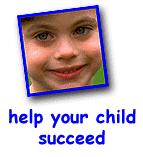





 |
 |
 |
||
 |
 |
 |
||
| |
|
|
|
|
| Home : BioPhysical Module : Online Reading 2 | ||||||||||||||||||||||||||||||||
Introduction to Development |
New born |
1 |
2 |
3 |
4 |
5 |
6 years |
|
|
|
|
|
need for structure and order
|
|
| unconscious awareness of language |
conscious
awareness of language
|
|
large
muscle control
|
hand coordination |
Erikson
suggested that critical periods extend to social and emotional development.
Human beings are really quite resilient, so it is difficult to determine
how lasting a trauma may be.
Critical periods may impact classroom management. This true story about
Stephanie is one example: Stephanie was criticized for a foolish response
in first grade. It only happened one time, but it was the last time Stephanie
raised her hand to answer a question, not just that year, but for the
rest of her school life. She moved to the rear of the classroom when given
a choice, and despite above average intelligence, she took every chance
she could to stay home.
First
grade is a time when initiative and industry vie with shame and doubt.
Was this a critical period in Stephanie's development? If she shared her
distress, could the teacher "undo" the emotional wound? Was
it the teacher, or did Stephanie have esteem problems elsewhere? Was Stephanie
born more emotionally fragile than her friends, or did others in the grade
also respond as she did to an overly critical experience? We can't be
sure, but it begs the question of critical periods as a function of understanding
and properly working with youth. Again, nature, nurture and time are integral
parts of personality.
Critical periods also are important in developing curriculum. Most youngsters
in the primary grades are consolidating large muscle control. Many do
not have enough eye-hand coordination to find writing or reading exciting.
Instead, many youngsters are pushed to cut, paste, draw, color, write
and make sense out of symbols before the internal push and readiness are
in place. This means students are not ready to relish tasks, may find
learning drudgery rather than stimulating. We could literally destroy
the likelihood that a person will love learning, writing, reading, by
pressing a personal or politically established time frame for learning.
Once a student experiences a series of learning failures, school challenges
may appear overwhelming. If the student also sees attempts to work effectively
as futile and finds productive means of controlling the school environment
to be unfulfilling, a new set of less positive and productive ways of
relating. If this happens once or twice, most students rise above the
failure and frustration, but if it is a consistent part of trying to learn,
who can blame them for day dreaming, rebelling, talking to neighbors rather
than staying on task, and sometimes, even lashing out in frustration?

Critical periods may have a great deal to do with discipline!
Ages and Stages
Once we began the scientific study of human development, observation became
a critical tool. As data were gathered and compiled, a pattern emerged.
Gesellās work is specific about the ages when skills or behaviors emerged.
His institute produced books alerting parents to "terrible two's"
and seven year olds as whiny, while eight year olds were more social and
settled.
![]() Do ages and stages correspond?
Do ages and stages correspond?
![]() Do the stages follow one another, or do some children skip certain stages?
Do the stages follow one another, or do some children skip certain stages?
![]() If ages and stages go together, do they occur in all cultures, or are
the findings more likely to apply to the cultures studied?
If ages and stages go together, do they occur in all cultures, or are
the findings more likely to apply to the cultures studied?
![]() Do boys and girls grow at different rates?
Do boys and girls grow at different rates?
![]() Do girls go through stages boys donāt? What about oldest or youngest children?
Do girls go through stages boys donāt? What about oldest or youngest children?
![]() Do they grow differently?
Do they grow differently?
![]() Are precocious youth able to jump over stages?
Are precocious youth able to jump over stages?
![]() If a child becomes fixated, does that mean he or she will have to catch
up by going through all the stages, or might a jump to peer appropriate
stages occur once safety and health are restored?
If a child becomes fixated, does that mean he or she will have to catch
up by going through all the stages, or might a jump to peer appropriate
stages occur once safety and health are restored?
There are many views about these questions. At this point, there is sufficient documentation to show that there are patterns of development, and that many children in the same grade are grappling with similar issues. Many fourth graders start clubs and are enthusiastic about playing and working together, while a great number of four year olds play next to rather than with other four year olds. Some in each group donāt match the general trend. Some fourth graders cannot play well in groups, and some fours love group play.
For some theories, Eriksonās socio-emotional stages, Gesellās observations
of physical development, Piagetās work on cognitive development, the sequence
may be fairly stable, but the rate of acquisition varies widely. We also
are not quite sure that stages are hierarchical [that students must go
through the stages in sequence and don't jump around or skip some steps].
We think that level four moral reasoning is more complex than level three,
but in all circumstances? Does everyone go through level three and advance
to level four reasoning? What about cognitive development and learning
styles? Are there some children who approach life in a linear more abstract
manner and some who always approach learning from a more hands on
way, seldom or never gaining the ability to or interest in reasoning abstractly?
These questions lead us to use care in over generalizing about ages and
stages, but in fact, a wide range of children do fit the ages and stages,
and take those stages consecutively.
Having an idea of the typical behavior for an age group is a critical
tool in managing the classroom. This is a good example. Whining and tattling
are typical behaviors for children in the second half of first grade and
most of second grade. Children this age are beginning to develop an awareness
of right and wrong -- not what will get them in trouble, but rather the
notion that black and white rules apply to everyone. They are terrific
judges of one another. They want adult approval and seem torn between
getting their own way and gaining approval, often paired with following
rules. Many children chew pencils, still suck on fingers or thumbs, chew
their nails and pick their noses.
Some of this may just be age appropriate, some of the behaviors increase
with frequency from stress. Gesell calls this stage, "life in a minor
key." It is in stark contrast to the "know-it-all" six
year old and the social and more self assured eight year old. In a typical
class, there will be a blend of youngsters expressing this range of behaviors.
A teacher can establish procedures that deal with tattling. Students can
be given guidance about social feelings about touching the nose and the
time and place for self soothing. Music, exercise and treats can help
keep spirits high. The teacher can watch for students who are less secure
and build a strong bond with those children who seem more fragile.
As the teacher learns more about behavior, community building becomes
easier. Though we laugh with Murphy's law, human beings do not behave
in that way. Our bodies repair themselves, often without any help. We
want to be happy, to care for others, to make good choices. When we do
not, we feel sad, disappointed, and work to regain stasis. Children want
to be successful, have an inborn curiosity, are resilient in efforts to
mature and hope to be liked, to have friends, to belong to and contribute
to community.

Holistic
View
Studying human development is complex. During early childhood, educators
see themselves working with social and emotional well being. To gain the
attention of students and prepare them for more difficult tasks, physical
development is also a function of teaching. However, as the child moves
beyond the primary grades, teachers are less likely to see the child from
a holistic perspective, and more often, the emphasis is on cognitive development
as the important thrust. This is further underscored by the changes in
testing and grading. During the early grades, we often find report cards
that mark social behavior, work ethic, and developmental milestones. We
seldom test in these areas but we monitor closely enough to observer and
report on them.
By junior high, cognitive development is obviously the focus, and in high school, each teacher instructs, tests and grades content, with few exceptions. This seems sensible, since it narrows the focus of school, but it cannot be considered good practice when one recognizes the importance of educating the whole child.
This begs
three questions:
![]() What
areas do we know we can recognize as developmental?
What
areas do we know we can recognize as developmental?
![]() Which
ones should education become involved in?
Which
ones should education become involved in?
![]() Where
will we find the time?
Where
will we find the time?
The scope
is set at five areas.
|
P |
Physical | Biological forces, height, weight, coordination, puberty |
| E | Emotional | Personality, ego strength, sense of self, traits |
| P | Philosophical | Super ego, reasoning about behavior, internal voice |
| S | Social | Relationship, Second person perspective, esteem referent |
| I | Intellectual | Cognition, way of reasoning, problem solving paradigm, IQ |
All of these areas have a developmental component. Each is the subject of research, and each is includes a range of abilities that forms a recognizable and observable frame for describing a class of related behaviors. Since it is the whole child who comes to us, not a being reducible to an intellect, it is the whole child we teach.
Read the
following examples of how different areas of development impact the cognitive
or intellectual focus.
Luis has diabetes. When his blood sugar drops, he becomes listless
and canāt seem to pay attention. The physical part of him is tied
to his behavior and to learning.

Yolanda
has cerebral palsy. She is very bright but cannot hold a pencil to write
out her letters. Her physical limitations make it difficult for
her to express what she knows, verbally, but she belongs in the gifted
program, intellectually. She gets teased and left out of recess
activities, so her social development is hampered.

Samantha
was tiny at birth due to maternal drinking. She was slow to walk, and
her physical agility is limited. She went from the hospital to
foster care, and her infancy was marked by stays in the hospital interspersed
with moves from one foster care situation to another. Her ability to trust
never materialized so her emotional development is sporadic. She
does seem to engage well with the teacher, and her ability to complete
her work seems to depend on the amount of time the teacher can work with
her, one on one. When the teacher provides support, Sam works, but when
the teacher leaves, Samantha loses focus and work efforts stall.

Dom
sits in the back of the room and stares off or doodles on a paper. He
doesnāt seem focused on school work and itās hard to tell if he is listening
to the teacher. He wasnāt very successful in kindergarten or first grade.
At times, the teacher goes to his desk, explains the task and gets him
started. Every time that happens, he completes the work, but then doesnāt
go on to the next task. His emotional development is solidly at
initiative vs. shame and doubt.

Leonard is in trouble again! He took colored pencils from another studentās desk and when asked about it, he replied that he didnāt have any and he needed them, so why all the fuss? His philosophical development is still pre-moral, a stark contrast from the black and white view of the other students in the sixth grade. He has trouble fitting in with peers. They laugh at his antics and think his fabrications are amusing, but they donāt view him as part of the group. Sometimes, Leonard gets so upset at not belonging that he strikes out at students or plays practical jokes on them rather than participating in the group activities. Leonard always seems to be at the bottom of class misunderstandings or uproars. His lack of progress in moral reasoning also contributes to problems in his social development.

Tiffany
sits near the library, reading a book. Sheās alone most of the time. Her
friends began to ostracize her when she spoke up in class about the importance
of preserving life and against hunting the local deer. She developed philosophical
reasoning that leads her to believe that all life is sacred. Her teen
aged friends canāt see what all the fuss is about, and find her impassioned
remarks amusing, giving them a great way to tease her and get under her
skin. Lately, her work has been slipping, and she seems detached during
class. She no longer offers any opinions, even when called on. Though
she is very bright, her lack of social acceptance, in part due
to her precocious life view, affects her intellectual development
in the school setting, for her lack of social acceptance saps her energy
and desire to move forward with school tasks.

Luke
acts like heās a bubble on a hot stove. The chemistry teacher finds him
especially trying. Students canāt focus on experiments if Luke is in their
group. Recently, one of the more mature student came up after class and
told the teacher that he would like to help with the teacherās request
to keep Luke in the group, but it just isnāt working. Luke always insists
on his own way, doesnāt follow directions, and then alienates the other
students by his verbal antics. Lukeās social age seems to be closer
to seven than seventeen.
Each of these scenarios shows ways development is having an impact on
teaching content. Each of these youngsters has a developmental level
that differs from the majority of the class, and in each case, the behavior
emerges as a discipline issue. Sometimes the student is "acting out"
and other times, it is the response of peers that is problematic. Viewing
children as growing, developing, even stalled or regressed, provides a
positive perspective for understanding and thus for redirecting the behavior
by helping the student "grow into" age appropriate responses.
Our view
of children suggests that growth, change, and learning are inherent. The
more holistic our view, the more behavior we are likely to understand.
As we become fluent in recognizing the behaviors and typical age appropriate
actions of youngsters, we gain facility in helping youngsters make productive,
age appropriate advancements.
This healthy school environment can include children empowering each other and facilitating growth of community. It can work together to build networks, a great foundation for productive, fully function, fully mature individuals who are prepared to work productively in situations with rapid change and who are ready to envelop personal challenges, international community, what ever the future brings. We not only graduate knowledgeable, life long learners, we move together to a more dynamic, emotional philosophical, social and intellectual maturity.
Collect a
![]() for completing this reading!
for completing this reading!
Go on to
Online Reading 3
or
Go back to Online Reading 1
Course Created by J'Anne Ellsworth & Center for Technology Enhanced Learning
Copyright
© 2001 Northern Arizona University
ALL RIGHTS RESERVED
 |
 |
 |
 |
 |
|